A sideways look at economics
I’ve always wondered what it’s like to be a lefty. Do people treat you differently? Have you got a more optimistic outlook on the world? Is the welfare state a necessity? These are all questions a leftist may or may not know the answers to. But are there any key differences between the ordinary, run-of-the-mill righty and the mythical, scarcely found left-handed person?
Research suggests that only 10-12% of the world’s population is left-handed. As a result, there are many situations in which being a lefty is judged as just not right, stemming right back to our childhoods. Nothing frightens a primary school teacher more than a left-handed student, haplessly wreaking havoc on the seating configuration and scissors distribution of the class. Guitars, violins, power-saws, can-openers and more all go ‘hand in hand’ with right-handers.[1] Even the use of one’s left hand for activities as trivial as eating can be considered rude, or unclean in many Asian and Middle Eastern cultures.
Today, lefties are only subjugated to a roasting on X (formerly Twitter). But during the Middle Ages, left-handed writers were often associated with the devil or accused of witchcraft, a crime punishable by… burning at the stake. Up until the 1960s, children were forced to write with their right hands in an attempt to convert the lefties. Even etymologists will tell you the word ‘left’ does not have pretty origins — “sinister” is derived from the Latin word for left, “Gauche” in French can mean “left” or “clumsy”, and the Anglo-Saxon word ‘lyft’ translates as ‘weak’. Life as a lefty can’t always feel so lucky.
But as a right-handed tennis player (with a one-handed backhand, a sparser sight than lefties these days), I know all too well the distinct advantage that left-handers have on court. Statistically, the best (and often most preferred) groundstroke of a tennis player is their forehand. The worst[2] (and usually least preferred) is the backhand. A crosscourt backhand or forehand, where the net is at its lowest point and the dimension of the court is at its longest, has the greatest margin for error of any groundstroke. Therefore, on average a player’s finest shot with the lowest risk of flying out or into the net is a forehand crosscourt.
The kicker for lefties? Their strongest weapon is going towards a right-handed player’s weakest groundstroke. Furthermore, right handers will usually have less experience playing left-handed players, something that isn’t the case for lefties facing righties; in tennis, survival of the ‘unexpected’ dominates survival of the ‘fittest’. It’s no wonder that 14% of the top 100 male professional tennis players are left-handed.[3] This strategy is so strong, coaches have often encouraged right-handed prodigies to play tennis with their left hand. The most obvious and successful example is the 22-time Grand Slam winner Rafael Nadal, and a more unknown instance being current GB number 1 Jack Draper, both of whom are naturally right-handed.[4] Since the beginning of the Open Era[5] 22.5% of male and 14.6% of female Grand Slam winners have been lefties. 43.1% of male lefty Grand Slams were won by a certain Rafa Nadal and 54.5% of female lefty Grand slams won by Martina Navratilova! Interestingly, between 1974 and 1984 every single men’s US Open victor was left-handed!
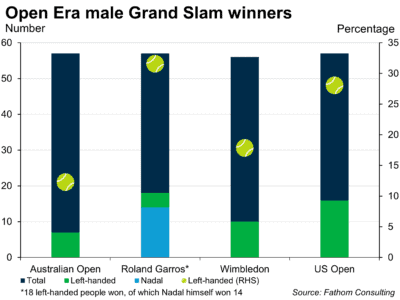
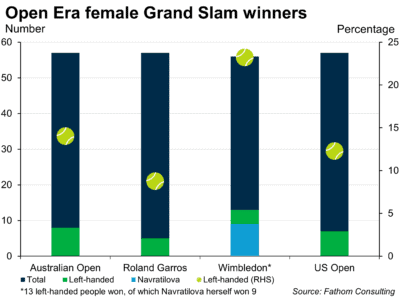
It seems this trend is common amongst virtually all sports, with the exception of football (unless you’re practicing Maradona-esq manoeuvres of course).[6] But it turns out the lefty trump cards don’t finish there. As many readers will already know, our cerebrums are cross wired, meaning the left hemisphere of the brain controls the right side of the body and vice versa. Also, common knowledge is the “comparative advantage” of each hemisphere, with the left hemisphere specialising in analytical, linear, factual, verbal, sequential, and logical processing and the right specialising in poncing around.[7]
In a world with such a tendency towards righties, there are numerous indications that left-handedness is associated with increased bilaterality of cognitive processing, as well as greater interhemispheric connectivity — i.e., lefties are more in touch with both sides of the brain than righties. This improved mobilisation of the mind not only improves ambidexterity but may also partially explain the reported findings that lefties have a higher likelihood of possessing an IQ score above 131, exhibiting exceptional mathematical ability, avoiding Parkinson’s disease, demonstrating increased language fluency, and having a superior memory (Gutwinski S., 2011). Not bad… However, left-handedness is also more prevalent among infants that underwent stressors during pregnancy,[8] and lefties have a higher probability of developing mental and emotional health conditions such as dyslexia and schizophrenia (Gutwinski S., 2011). So, being left-handed appears to endow both advantages and disadvantages, which overall do not garner any discernible dominance over righties.
But how does this translate to economics? Does a marked interhemispheric connectivity equal greater productivity? Are lefties higher earners than righties? Should I start brushing my teeth with my left hand? A 2014 Harvard study by Economist Joshua Goodman finds that left-handed individuals earned 10-12% less annually than their right-handed counterparts. However, the paper is inconclusive as to whether such gaps are caused by left-handedness or instead ‘arise from other factors for which left-handedness is simply a proxy.’ (Goodman, 2014, p. 209). Ruebeck, Harrington and Moffit (Ruebeck, 2007) found that left-handed, college-educated males actually earned a 15% premium over their male college-educated righty peers, though the same relationship was not observed amongst college-educated females. Left-handed males were also found to earn 4% more per hour than right-handers by Denny and O’Sullivan (Denny, 2007), but the opposite was discovered for left-handed females. Both papers, however, point out that the inclusion of ‘laterality’ in an earnings equation is somewhat futile since it lacks a strong theoretical foundation. At Fathom, only 8.8% of the current employees are left-handed. But they certainly over-compensate in terms of years at the company, having worked on average 10.1 years more than the righties!
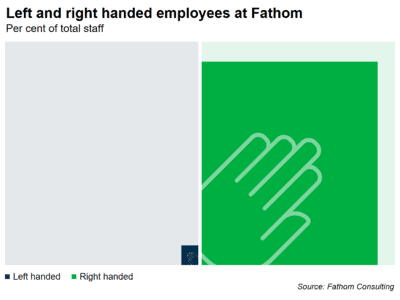
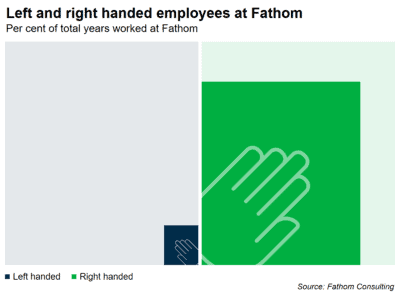
Concerning the current body of research on the determinants of wages, handedness is, as one would expect, far less substantial compared to education levels, occupation choice and quality of one-handed backhands. Furthermore, identifying the causality of left-handedness on a variety of socio-economic factors is particularly difficult for a multitude of reasons. Primarily because humans haven’t figured out a clear way to manipulate the neurological wiring that determines left or right handedness. Even education levels and occupation choice often fall prey to issues such as ability bias, which refers to the distortion in estimating the effects of those factors on outcomes such as earnings due to pre-existing differences in ability among individuals. Ability bias arises when someone with a higher inherent ability, such as intelligence, is more likely to pursue education, thus making it tricky to separate the effect of education from the effect of ability.
So, what’s my advice for the big-headed righty, depriving their left hand of attention or respect, and the anxious lefty, trying to navigate a right-handed world? Righties, using your non-dominant left hand more frequently probably won’t secure you a bonus any time soon, but it may improve your bilaterality of cognitive processing, which can’t be a bad thing! Lefties, be proud of your individuality! Let people know your handedness. Go in for a left-handed handshake at that next job interview. Perhaps this world needs even less lampooning of the lefties!
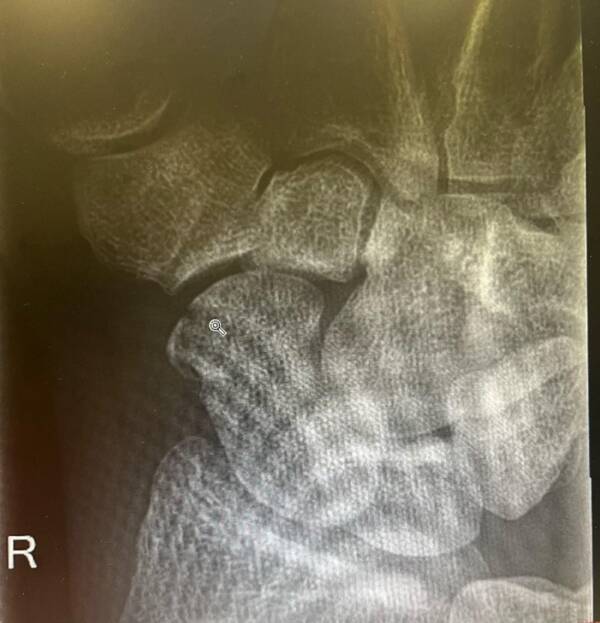
My fractured right wrist, May 2024 — the moment I realised I needed to embrace the left!
[1] According to one left-handed Fathom employee, who will remain anonymous, string instruments and cutlery actually favour left-handed people. Their belief is the more complicated task is performed by the left hand. This is part of their wider conspiracy theory that the world is controlled by lefties.
[2] Discounting serves, volleys and drop-shots, which many players will claim are even worse than their backhand.
[3] Tennis Abstract: WTA Lefthander Rankings as of 11 February 2025, only 8% of the top 100 female players are left-handed.
[4] Other active players that play with their non-dominant hand: Nishioka, Coric, Paul, Badosa, and Fernandez. Notable retired players that played with their non-dominant hand: Ken Rosewall, Sharapova, Kerber, Haase and Young.
[5] The Open Era, which began in 1968 Roland Garros, marks the point where amateurs and professionals could compete together at tournaments, in turn allowing more people to make a living playing tennis.
[6] During the 1986 FIFA World Cup quarter final between England and Argentina, Diego Maradona scored an infamous goal in his team’s 2-1 victory that went down in history as le mano de Dios. The [left] hand of God. Interestingly, being left-handed is not more commonly associated with being left footed (Messi is right-handed)!
[7] The right hemisphere of the brain is associated with imaginative, artistic, intuitive, creative and emotional processing.
[8] Over 50% of all newborns with a very low birth weight (under 1000g) are left-handed.
Sources:
Denny, K. &. (2007). The Economic Consequences of Being Left-Handed: Some Sinister Results. Journal of Human Resources, 353-374.
Goodman, J. (2014). The Wages of Sinistrality: Handedness, Brain Structure, and Human Capital Accumulation. Journal of Economic Perspectives, 28(4), 193-212.
Gutwinski S., L. A. (2011). Understanding Left-Handedness. Dtsch Artztebl Int, 849-853.
Ruebeck, C. S. (2007). Handedness and Earnings. Laterality, 101-120.
More from Thank Fathom it’s Friday